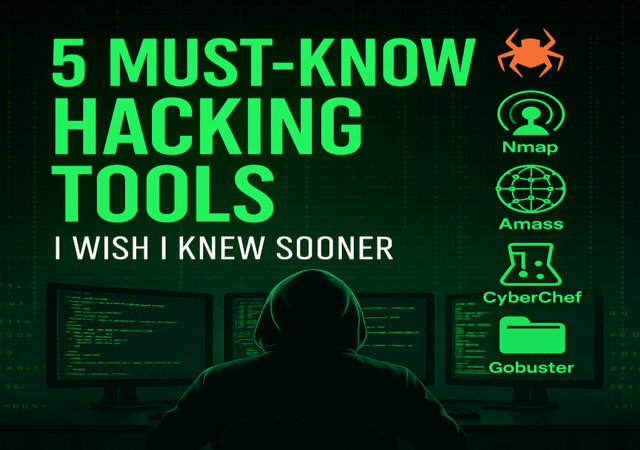5 Tools I Wish I Knew When I Started Hacking

As I entered the world of hacking and cybersecurity, I was bombarded with the quantity of tools available. Each YouTube video, course, or website had a list of "must-have" tools that differed from one another, and I had no idea where to begin. After a while, I tried, messed up, learned, and ultimately discovered which tools actually helped.
5 Hacking Tools
Here in this blog, I would like to introduce five hacking tools that I wish I had known about when I was beginning to hack. They are easy to use for beginners, immensely powerful, and immensely popular across the industry. If you are new, or even if you are experienced, these can become your new go-to's.
Prefer watching instead of reading? Here’s a quick video guide
Burp Suite
Category: Web Application Testing
Why It's Useful: Intercept and tamper web traffic.
When I first started web hacking, I was doing a lot of manual testing—viewing HTML source code, using browser developer tools, or executing simple scripts. I had heard of Burp Suite but steered clear of it because it seemed daunting.
Big mistake.
Burp Suite is a Swiss Army knife for web application penetration testing. It lets you:
- Intercept HTTP/HTTPS traffic between your browser and the target site.
- Alter requests and responses in real time.
- Test inputs repeatedly with Intruder.
- Spider sites to crawl all accessible pages.
- Scan for typical web vulnerabilities (Pro version).
I now use Burp Suite for nearly all web app testing. Even the free version is extremely capable and more than sufficient for beginners.
Pro tip: Have Burp Suite Community Edition work together with FoxyProxy in Firefox to redirect traffic simply through Burp.
Nmap
Category: Network Scanning
Why It's Useful: Find open ports, services, and vulnerabilities.
Initially, I downplayed Nmap. I assumed that it was "just a port scanner." But the more I delved, the more I appreciated how useful and versatile it is.
Nmap is capable of:
- Discovering live hosts on a network.
- Scanning open ports and the service they are running.
- Guessing operating systems and hardware information.
- Executing scripts with the use of NSE (Nmap Scripting Engine) to identify vulnerabilities.
For instance, this command provides you with a lot of information:
nmap -sC -sV -A target.comIt performs a default script scan (-sC), version detection (-sV), and aggressive scan (-A) all at once.
Pro tip: When performing CTFs or actual testing, always begin with Nmap to get a lay of the land.
Amass
Category: Reconnaissance / Subdomain Enumeration
Why It's Useful: Discover hidden subdomains and increase attack surface.
Recon is perhaps the most important aspect of ethical hacking. The better you know your target, the higher your chances of discovering vulnerabilities.
When I began, I relied on basic tools such as sublist3r or online subdomain finders. But Amass revolutionized everything.
Amass is an incredibly useful tool for:
- Finding subdomains from multiple data sources.
- Mapping domain relationships.
- Performing active and passive recon.
A simple command such as:
amass enum -d example.comcan expose dozens of subdomains you might not have discovered otherwise.
Pro tip: Cross-reference Amass findings with tools such as httpx to see which subdomains are alive and accessible.
CyberChef
Category: Data Encoding/Decoding
Why It's Useful: Rapidly transform, encode, decode, or inspect data.
I used to spend hours trying to manually decode base64 or coding Python scripts just to xor-decrypt a string. Then I stumbled upon CyberChef, and it was like magic.
CyberChef is a browser-based tool by GCHQ (UK's intelligence agency). It enables you to perform a variety of data operations including:
- Base64 encode/decode
- Hex to ASCII
- XOR encryption/decryption
- Hashing (MD5, SHA256, etc.)
- JWT analysis
- Regex extraction
It's drag-and-drop simple where you pile up different "operations" in a pipeline. Super intuitive, super quick.
Pro tip: Bookmark CyberChef (https://gchq.github.io/CyberChef/) — it'll save you hundreds of hours.
Gobuster
Category: Directory/Content Enumeration
Why It's Handy: Find hidden directories and files on web servers.
Ever gone to a website and wondered, "There's more to this"? That's where Gobuster comes in. It brute-forces files and directories on a web server with a wordlist.
gobuster dir -u http://example.com -w /usr/share/wordlists/dirbuster/directory-list-2.3-medium.txtIt attempts hundreds or thousands of typical folder and file names to find hidden pages such as:
- /admin
- /login
- /backup.zip
Why should this matter? Often, these pages aren't referenced from anywhere on the website. Discovering them can expose tasty vulnerabilities.
Tip: Use Gobuster with a decent wordlist such as SecLists, and scan various status codes (e.g., 200, 403, 301).
Final Thoughts
Hacking is half creativity and attitude, and half tools. But the proper tools can make you a superhero—allowing you to automate drudgery, discover previously unknown weaknesses, and get things done more quickly.
These five tools—Burp Suite, Nmap, Amass, CyberChef, and Gobuster—are ones I've always regretted not mastering sooner. If you're just beginning, I wholeheartedly urge you to dive into each of them individually. Not only learn how to use them, but also why they function the way they do.
And don't forget: tools change, but knowledge remains.
Bonus Tips
- Don't attempt to learn everything at once. Learn one, practice it in a lab or CTF, and proceed to the next.
- Keep yourself updated. Most tools receive new features or bug fixes on a regular basis.
- Monitor GitHub repos of these tools for updates and read their documentation.




